Impacts of GPS Spoofing on Path Planning of Unmanned Surface Ships
Abstract
:1. Introduction
- To the best of our knowledge, this is the first time the influence of GPS spoofing on the path planning of unmanned ships is researched using the artificial potential field method;
- We study the security of GPS and propose a GPS attack using a low-cost software-defined radio, which can cause deviations to the result of path planning based on the artificial potential field method, leading to path yaw. Our simulation results show that this method can influence the path planning results of the artificial potential field method;
- We study the feasibility of using low-cost and portable GPS spoofers to implement GPS spoofing and conduct a practical test.
2. Artificial Potential Field
2.1. Traditional Artificial Potential Field
2.2. Modified Artificial Potential Field (APF)
3. GPS Attack Designs and Spoofing Analysis
3.1. GPS Introduction
3.2. GPS Attacks
- A jamming attack happens when a GPS jammer transmits strong jamming signals at the same frequency, which suppress the front-end signal of the GPS receiver so that the GPS receiver loses the ability to work or receive attenuated satellite signals. Jamming attacks have the advantages of simple operation and easy implementation. However, the power required for a jamming signal is large;
- A spoofing attack happens when a GPS spoofer transmits the same or similar signal as a GPS signal to guide the GPS receiver to deviate from the original correct navigation and positioning. Spoofing attacks have the advantages of strong concealment.
3.2.1. GPS Jamming
3.2.2. GPS Spoofing
3.2.3. Designing a GPS Attack
3.3. Spoofing Analysis
4. Experiments
4.1. GPS Spoofing Simulation
4.2. APF Simulation
5. Conclusions
Author Contributions
Funding
Conflicts of Interest
References
- Wikipedia. Unmanned Surface Vehicle. Available online: https://en.wikipedia.org/wiki/Unmanned_surface_vehicle (accessed on 16 November 2020).
- Gao, X.; Li, T.; Shan, Q.; Xiao, Y.; Yuan, L.; Liu, Y. Online optimal control for dynamic positioning of vessels via time-based adaptive dynamic programming. J. Ambient. Intell. Humaniz. Comput. 2019, 1–13. [Google Scholar] [CrossRef]
- Rødseth, Ø.J.; Burmeister, H.C. Developments toward the unmanned ship. Proc. Int. Symp. Inf. Ships–ISIS 2012, 201, 30–31. [Google Scholar]
- Yang, Y.; Xiao, Y.; Li, T. A Survey of Autonomous Underwater Vehicle Formation: Performance, Formation Control, and Communication Capability. IEEE Commun. Surv. Tutor. 2021, 23, 815–841. [Google Scholar] [CrossRef]
- Kim, J.; Kim, S.; Choo, Y. Stealth path planning for a high speedtorpedo-shaped autonomous underwater vehicle to approach a target ship. Cyber-Phys. Syst. 2018, 4, 1–16. [Google Scholar] [CrossRef]
- Wang, J.; Xiao, Y.; Li, T.; Chen, C.P. A Survey of Technologies for Unmanned Merchant Ships. IEEE Access 2020, 8, 224461–224486. [Google Scholar] [CrossRef]
- Li, M.; Li, T.; Gao, X.; Shan, Q.; Chen, C.L.P.; Xiao, Y. Adaptive NN Event-triggered Control for Path Following of Underactuated Vessels with Finite-time Convergence. Neurocomputing 2020, 379, 203–213. [Google Scholar] [CrossRef]
- Jun, W.; Haoyang, G. Virtual force field coverage algorithms forwireless sensor networks in water environments. Int. J. Sens. Netw. 2020, 32, 174–181. [Google Scholar] [CrossRef]
- Shi, Q.; Li, T.; Li, J.; Chen, C.P.; Xiao, Y.; Shan, Q. Adaptive Leader-following Formation Control with Collision Avoidance for a Class of Second-order Nonlinear Multi-agent Systems. Neurocomputing 2019, 350, 282–290. [Google Scholar] [CrossRef]
- Xie, S.; Wu, P.; Peng, Y.; Luo, J.; Qu, D.; Li, Q.; Gu, J. The obstacle avoidance planning of USV based on improved artificial potential field. In Proceedings of the 2014 IEEE International Conference on Information and Automation (ICIA), Hailar, Hulun Buir, China, 28–30 July 2014; pp. 746–751. [Google Scholar]
- Lyu, H.; Yin, Y. Ship’s trajectory planning for collision avoidance at sea based on modified artificial potential field. In Proceedings of the 2017 2nd International conference on robotics and automation engineering (ICRAE), Shanghai, China, 29–31 December 2017; pp. 351–357. [Google Scholar]
- Lyu, H.G.; Yin, Y. COLREGS-constrained real-time path planning for autonomous ships using modified artificial potential fields. J. Navig. 2019, 72, 588–608. [Google Scholar] [CrossRef]
- Zhang, R.; Wen, N.; Yu, H.; Wang, L.; Wu, J.; Liu, G. USVs Cooperative Collision Avoidance Based on Man–Machine Interaction and the Artificial Potential Field Method. In Proceedings of the 2019 Chinese Automation Congress (CAC), Hangzhou, China, 22–24 November 2019; pp. 1552–1557. [Google Scholar]
- Yuan, L.; Li, T.; Tong, S.; Xiao, Y.; Shan, Q. Broad Learning System Approximation-Based Adaptive Optimal Control for Unknown Discrete-Time Nonlinear Systems. IEEE Trans. Syst. Man Cybern. Syst. 2021, 1–11. [Google Scholar] [CrossRef]
- Yu, K.; Liang, X.F.; Li, M.Z.; Chen, Z.; Yao, Y.L.; Li, X.; Zhao, Z.X.; Teng, Y. USV path planning method with velocity variation and global optimisation based on AIS service platform. Ocean. Eng. 2021, 236, 109560. [Google Scholar] [CrossRef]
- Zhang, D.; Zhang, Y.; Zhang, C. Data mining approach for automatic ship-route design for coastal seas using AIS trajectory clustering analysis. Ocean. Eng. 2021, 236, 109535. [Google Scholar] [CrossRef]
- Yang, Y.; Xiao, Y.; Li, T. Attacks on Formation Control for Multi-agent Systems. IEEE Trans. Cybern. 2021, 1–13. [Google Scholar] [CrossRef]
- Wang, Y.; Zhang, S.; Zhang, Y.; Wan, P.; Wang, S. A cooperative spectrum sensing method based on signal decomposition and K-medoids algorithm. Int. J. Sens. Netw. 2019, 20, 171–180. [Google Scholar] [CrossRef]
- Huang, L.; Lv, Z.; Wang, F. Research on Deception Jamming for Satellite Navigation Receiver. J. Astronaut. 2012, 33, 884–890. [Google Scholar]
- Sfeir, J.; Saad, M.; Saliah-Hassane, H. An improved artificial potential field approach to real-time mobile robot path planning in an unknown environment. In Proceedings of the 2011 IEEE international symposium on robotic and sensors environments (ROSE), Montreal, QC, Canada, 17–18 September 2011; pp. 208–213. [Google Scholar]
- Yu, Z.Z.; Yan, J.H.; Zhao, J.; Chen, Z.F.; Zhu, Y.H. Mobile robot path planning based on improved artificial potential field method. Harbin Gongye Daxue Xuebao (J. Harbin Inst. Technol.) 2011, 43, 50–55. [Google Scholar]
- Rostami, S.M.H.; Sangaiah, A.K.; Wang, J.; Liu, X. Obstacle avoidance of mobile robots using modified artificial potential field algorithm. Eurasip J. Wirel. Commun. Netw. 2019, 2019, 1–19. [Google Scholar] [CrossRef] [Green Version]
- Psiaki, M.L.; Humphreys, T.E. GNSS spoofing and detection. Proc. IEEE 2016, 104, 1258–1270. [Google Scholar] [CrossRef]
- Tippenhauer, N.O.; Pöpper, C.; Rasmussen, K.B.; Capkun, S. On the requirements for successful GPS spoofing attacks. In Proceedings of the 18th ACM Conference on Computer and Communications Security, Chicago, IL, USA, 14–21 October 2011; pp. 75–86. [Google Scholar]
- Hambling, D. GPS Cyberattack Falsely Placed UK Warship Near Russian Naval Base. Available online: https://www.newscientist.com/article/2282149-gps-cyberattack-falsely-placed-uk-warship-near-russian-naval-base/ (accessed on 30 July 2021).
- Cheng, H.; Liu, J.; Xu, T.; Ren, B.; Mao, J.; Zhang, W. Machine learning based low-rateDDoS attack detection for SDN enabled IoT networks. Int. J. Sens. Netw. 2020, 34, 56–69. [Google Scholar] [CrossRef]
- Khatib, O. Real-time obstacle avoidance for manipulators and mobile robots. In Proceedings of the 1985 IEEE International Conference on Robotics and Automation, St. Louis, MO, USA, 25–28 March 1985; Volume 2, pp. 500–505. [Google Scholar]
- Goodwin, E.M. A Statistical Study of Ship Domains. J. Navig. 1973, 28, 328–344. [Google Scholar] [CrossRef] [Green Version]
- Sgorbissa, A.; Zaccaria, R. Planning and obstacle avoidance in mobile robotics. Robot. Auton. Syst. 2012, 60, 628–638. [Google Scholar] [CrossRef]
- Volpe, J.A. Vulnerability Assessment of the Transportation Infrastructure Relying on the Global Positioning System. Available online: http://www.navcen.uscg.gov/ (accessed on 10 August 2021).
- Ullah, I.; Bizzat Hussain, S.N.; Khan, U.; Ali, M.; Manzoor, S. An Inertial and Global Positioning System based Algorithm for Ownship Navigation. Int. J. Sens. Netw. 2021, 37, 209–218. [Google Scholar] [CrossRef]
- Warner, J.S.; Johnston, R.G. GPS spoofing countermeasures. Homel. Secur. J. 2003, 25, 19–27. [Google Scholar]
- Fyfe, P.; Kovach, K. Navstar GPS Space Segment/Navigation User Interfaces (Public Release Version); Technical Report; Research Corp Fountain: Valley, CA, USA, 1991. [Google Scholar]
- Gilmore, S.; Delaney, W. Jamming of GPS Receivers: A Stylized Analysis; Project Report; Lincoln Laboratory: Lexington, MA, USA, 1994. [Google Scholar]
- Dou, Y.; Zhang, W.; Chen, J. Analysis of Anti-interference performance of GPS receiver. Ordnance Ind. Autom. 2006, 25, 50–52. [Google Scholar]
- Rash, G.D. GPS jamming in a laboratory environment. In Proceedings of the 53rd Annual Meeting of the ION, Albuquerque, NM, USA, 30 June–2 July 1997. [Google Scholar]
- Grant, A.; Williams, P.; Ward, N.; Basker, S. GPS jamming and the impact on maritime navigation. J. Navig. 2009, 62, 173–187. [Google Scholar] [CrossRef] [Green Version]
- Iyidir, B.; Ozkazanc, Y. Jamming of GPS receivers. In Proceedings of the IEEE 12th Signal Processing and Communications Applications Conference, Kusadasi, Turkey, 30–30 April 2004; pp. 747–750. [Google Scholar]
- Wen, H.; Huang, P.Y.R.; Dyer, J.; Archinal, A.; Fagan, J. Countermeasures for GPS signal spoofing. In Proceedings of the 18th International Technical Meeting of the Satellite Division of the Institute of Navigation (ION GNSS 2005), Long Beach, CA, USA, 13–16 September 2005; Volume 5, pp. 13–16. [Google Scholar]
- Montgomery, P.Y. Receiver-autonomous spoofing detection: Experimental results of a multi-antenna receiver defense against a portable civil GPS spoofer. In Radionavigation Laboratory Conference Proceedings; Disney’s Paradise Pier Hotel: Anaheim, CA, USA, 2011. [Google Scholar]
- Humphreys, T.E.; Ledvina, B.M.; Psiaki, M.L.; O’Hanlon, B.W.; Kintner, P.M. Assessing the spoofing threat: Development of a portable GPS civilian spoofer. In Radionavigation Laboratory Conference Proceedings; Savannah International Convention Center: Savannah, GA, USA, 2008. [Google Scholar]
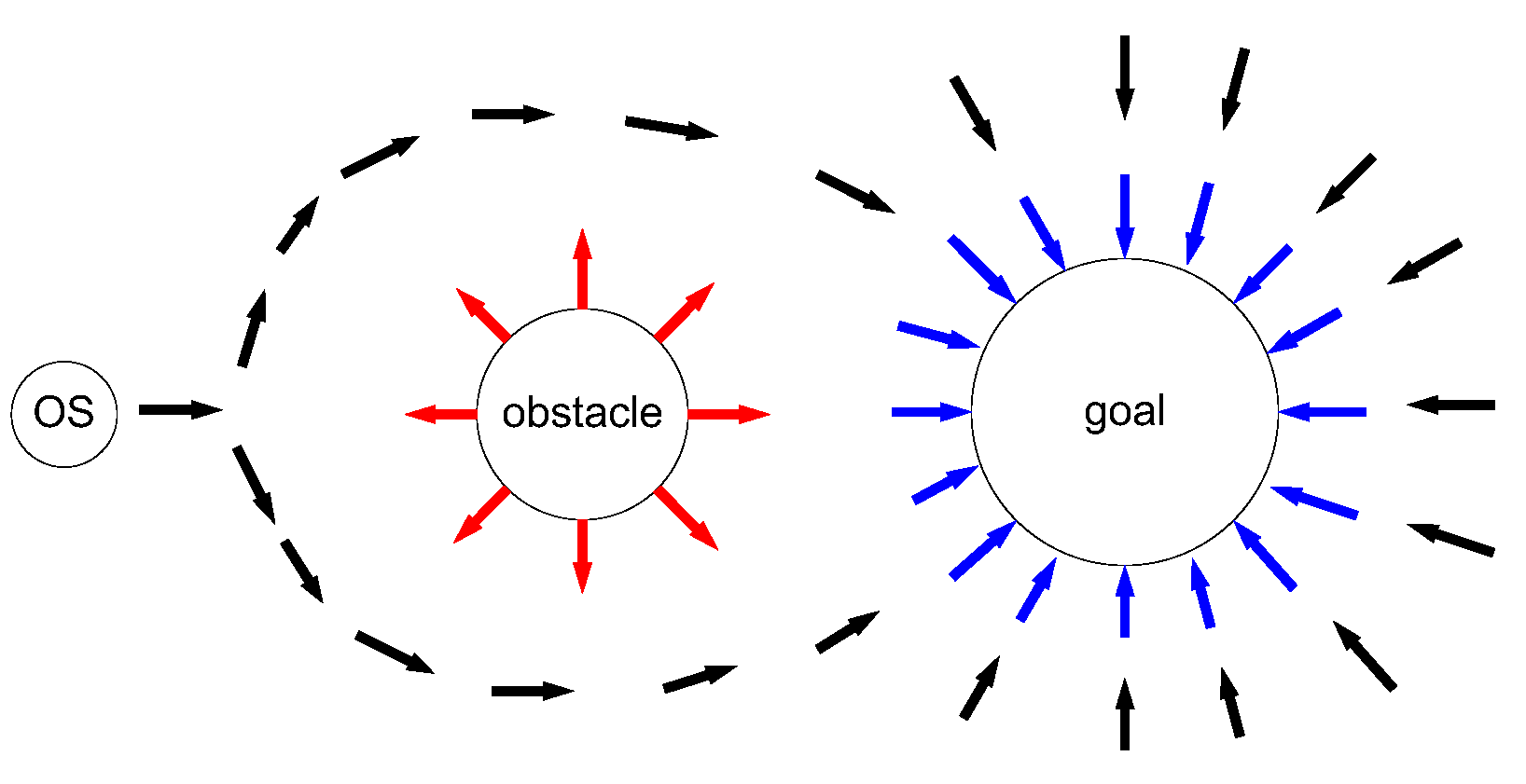



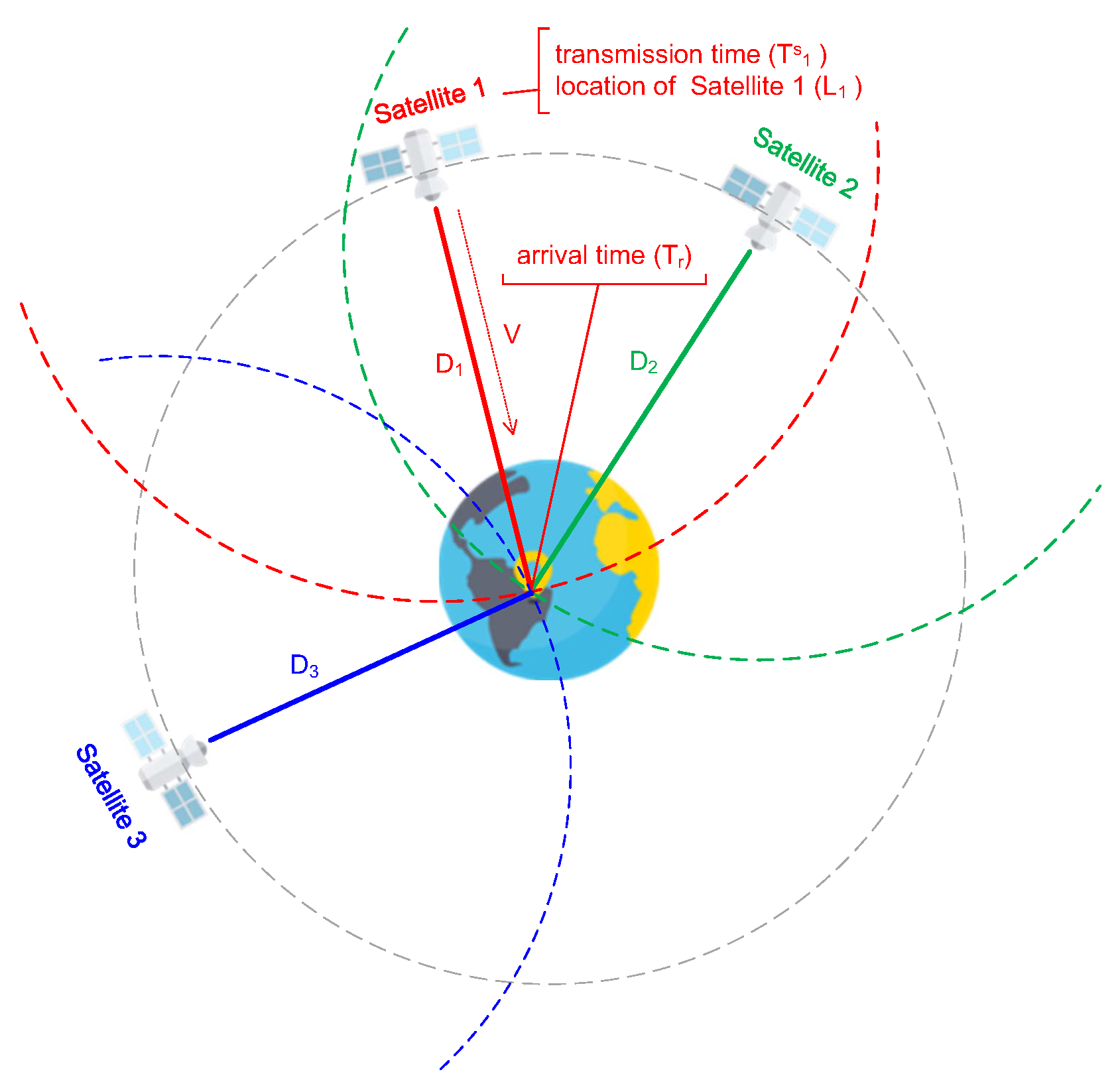
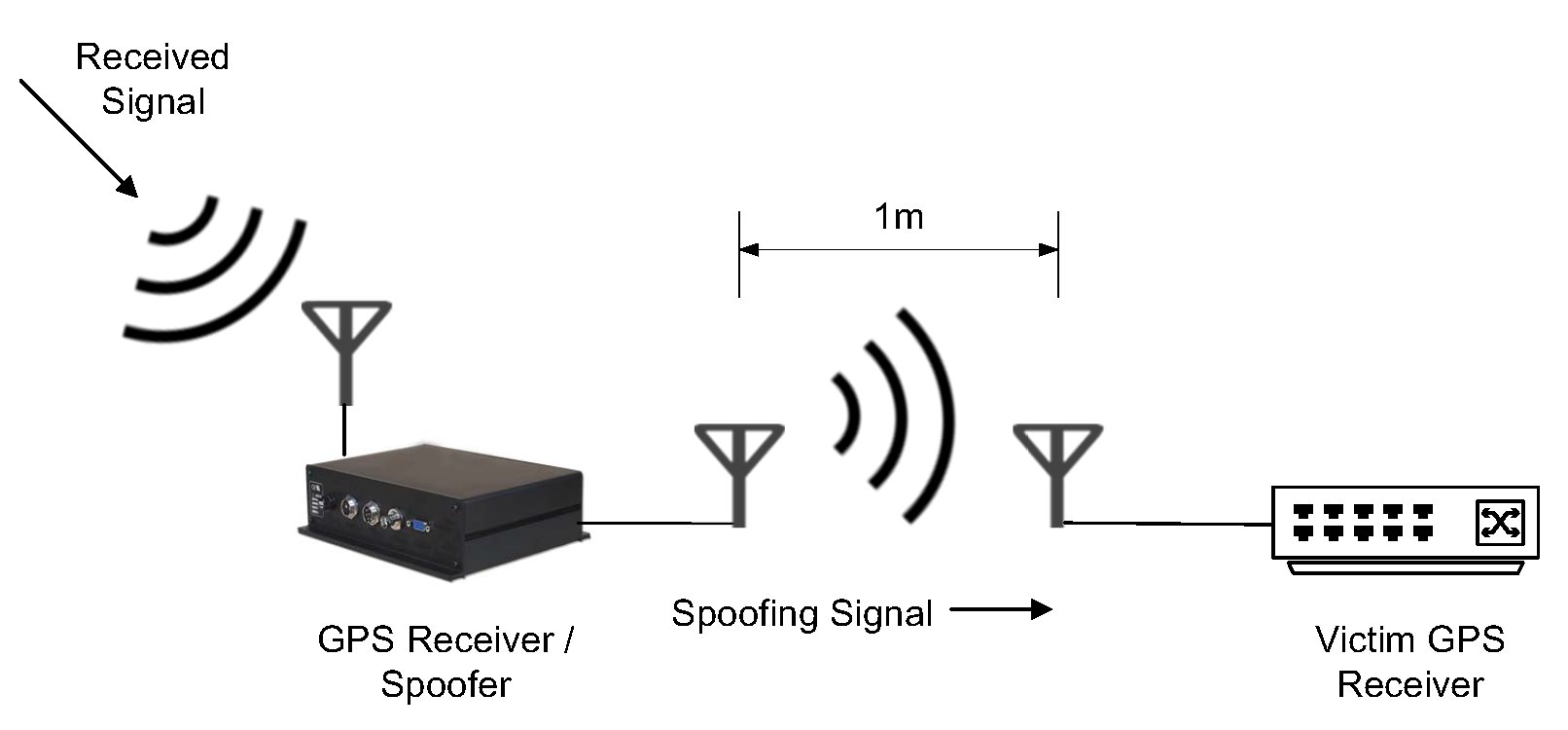
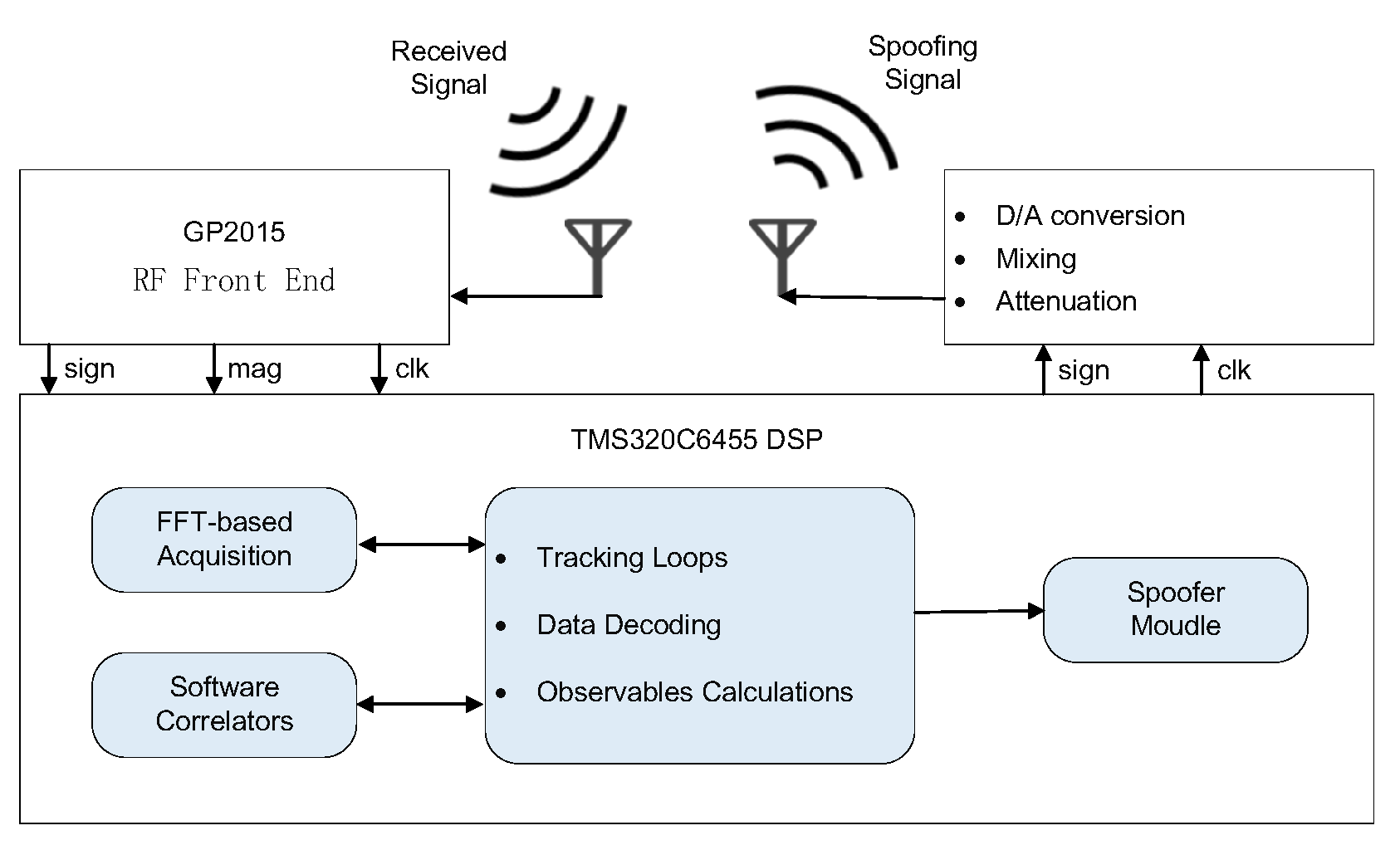











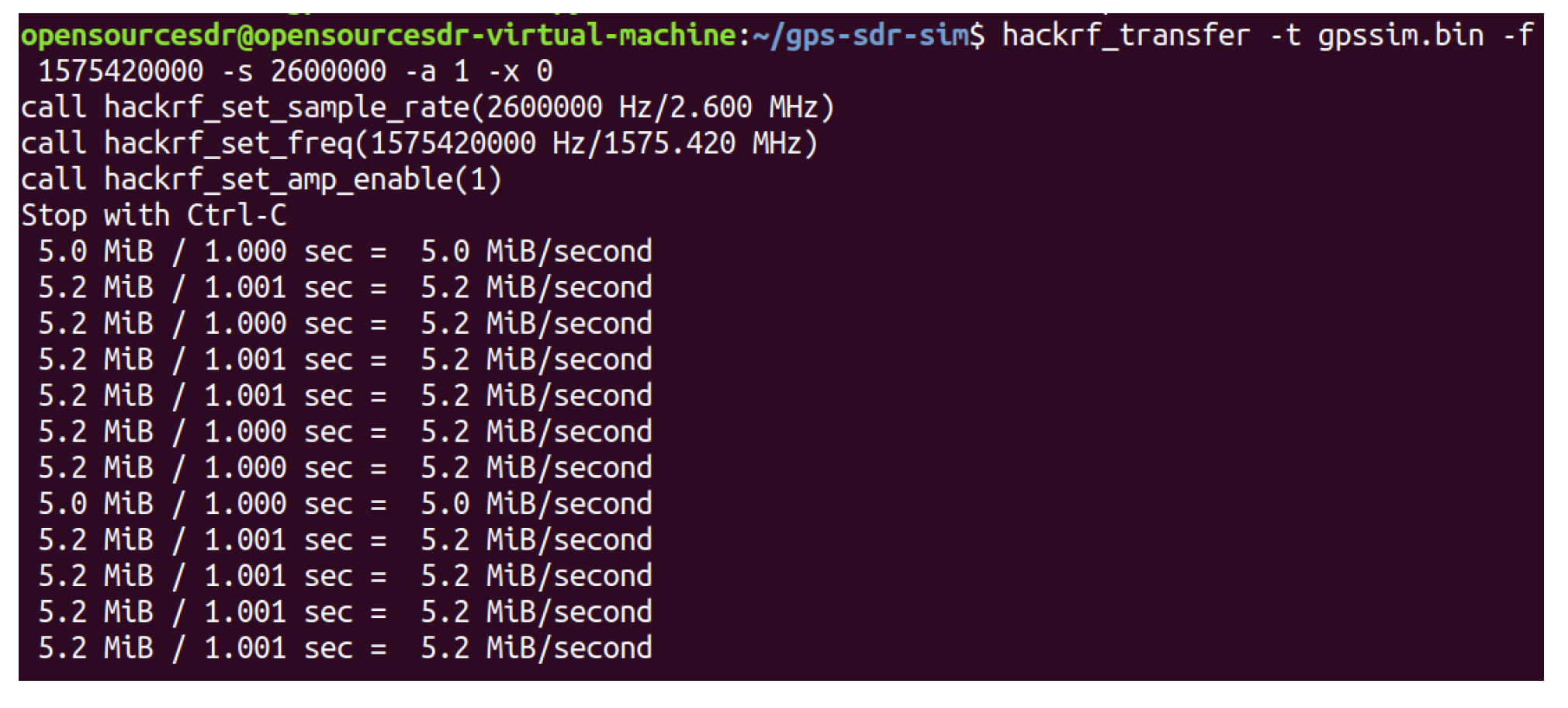




| Item | Value |
|---|---|
| Hardware | HackRF ONE |
| Operation System | Ubantu 64 bit |
| Network | China Mobile LTE, China Unicom LTE |
| Antenna | 700–2700 MHZ |
| Clock | GPS external clock |
| GPS Receiver | Xiaomi 6 mobile phone |
| Test App | GPS Test Plus 1.5.3 |
| False Position x | False Position y | Next Position x | Next Position y | x Offset | y Offset |
|---|---|---|---|---|---|
| 0.1 | 0 | 0.1385 | 0.1443 | 0.0015 | 0.0043 |
| 0.2 | 0 | 0.1337 | 0.1487 | 0.0063 | 0.0087 |
| 0.3 | 0 | 0.1320 | 0.1503 | 0.0080 | 0.0103 |
| 0.4 | 0 | 0.1336 | 0.1488 | 0.0064 | 0.0088 |
| 0.5 | 0 | 0.1353 | 0.1473 | 0.0047 | 0.0073 |
| 0.6 | 0 | 0.1363 | 0.1464 | 0.0037 | 0.0064 |
| 0.7 | 0 | 0.1366 | 0.1461 | 0.0034 | 0.0061 |
| 0.8 | 0 | 0.1366 | 0.1460 | 0.0034 | 0.0060 |
| 0.9 | 0 | 0.1364 | 0.1462 | 0.0036 | 0.0062 |
| 1 | 0 | 0.1361 | 0.1466 | 0.0039 | 0.0066 |
| 0 | 0.1 | 0.1417 | 0.1412 | 0.0017 | 0.0012 |
| 0 | 0.2 | 0.1426 | 0.1402 | 0.0026 | 0.0002 |
| 0 | 0.3 | 0.1437 | 0.1391 | 0.0037 | 0.0009 |
| 0 | 0.4 | 0.1449 | 0.1379 | 0.0049 | 0.0021 |
| 0 | 0.5 | 0.1460 | 0.1367 | 0.0060 | 0.0033 |
| 0 | 0.6 | 0.1470 | 0.1356 | 0.0070 | 0.0044 |
| 0 | 0.7 | 0.1480 | 0.1345 | 0.0080 | 0.0055 |
| 0 | 0.8 | 0.1490 | 0.1334 | 0.0090 | 0.0066 |
| 0 | 0.9 | 0.1499 | 0.1323 | 0.0099 | 0.0077 |
| 1 | 0 | 0.1361 | 0.1466 | 0.0039 | 0.0066 |
| 2 | 0 | 0.1293 | 0.1526 | 0.0107 | 0.0126 |
| 3 | 0 | 0.1202 | 0.1599 | 0.0198 | 0.0199 |
| 4 | 0 | 0.1094 | 0.1674 | 0.0306 | 0.0274 |
| 5 | 0 | 0.0970 | 0.1749 | 0.0430 | 0.0349 |
| 6 | 0 | 0.0829 | 0.1820 | 0.0571 | 0.0420 |
| 7 | 0 | 0.0671 | 0.1884 | 0.0729 | 0.0484 |
| 8 | 0 | 0.0497 | 0.1937 | 0.0903 | 0.0537 |
| 9 | 0 | 0.0310 | 0.1976 | 0.1090 | 0.0576 |
| 10 | 0 | 0.0114 | 0.1997 | 0.1286 | 0.0597 |
Publisher’s Note: MDPI stays neutral with regard to jurisdictional claims in published maps and institutional affiliations. |
© 2022 by the authors. Licensee MDPI, Basel, Switzerland. This article is an open access article distributed under the terms and conditions of the Creative Commons Attribution (CC BY) license (https://creativecommons.org/licenses/by/4.0/).
Share and Cite
Wang, J.; Xiao, Y.; Li, T.; Chen, C.L.P. Impacts of GPS Spoofing on Path Planning of Unmanned Surface Ships. Electronics 2022, 11, 801. https://doi.org/10.3390/electronics11050801
Wang J, Xiao Y, Li T, Chen CLP. Impacts of GPS Spoofing on Path Planning of Unmanned Surface Ships. Electronics. 2022; 11(5):801. https://doi.org/10.3390/electronics11050801
Chicago/Turabian StyleWang, Jia, Yang Xiao, Tieshan Li, and C. L. Philip Chen. 2022. "Impacts of GPS Spoofing on Path Planning of Unmanned Surface Ships" Electronics 11, no. 5: 801. https://doi.org/10.3390/electronics11050801







